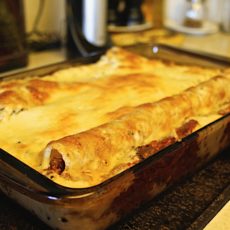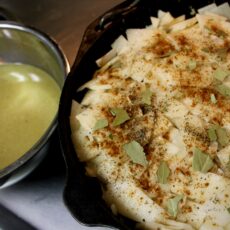Sweet-and-sour is not new for Simply Delicious–there’s already 6-27: Sweet-and-Sour Chicken and 11-6: Sweet and Sour Shrimp if you’re in the mood for a different protein besides pork. However, 7-37: Easy Sweet-and-Sour Pork is the only one to advertise itself as “easy”.

Pork is probably the most common version of sweet-and-sour that you see in Chinese restaurants–there’s even a vegan version of it you can buy in most stores. In case you’re looking for something more refined (but maybe not as easy or meatless), here’s Serious Eats’ take on it.

Interesting that they give you a chicken variation in the TIPS when they have a chicken version in their own book. I’d suggest taking them up on the pineapple addition though–the main recipe doesn’t include it, and it’s usually featured in most versions of the dish.

Ingredients. I’ve recently been trying to make a lot of my own meat substitutes from scratch rather than buy them–not only because it’s difficult to grocery shop these days, but because it’s more cost-effective in the long run and less impactful to the environment. Therefore, those chop-looking lumps in the plastic bag in the front-left side of the picture are “porq” chops (recipe courtesy of The Gentle Chef).
FYI: If you swap the soy sauce for tamari, this recipe can be made gluten-free. Don’t opt for the “porq” if you’re doing that though, because that stuff is the opposite of gluten-free.

Slicing up my porq. Since this isn’t real meat, it doesn’t need to be “cooked” to be edible. However, it still needs “finishing”, so we’ll modify the recipe a bit to make it all work. Instead of doing a marinade, I’ll use the sauce ingredients in a sauté/pan sauce at the end.

Sliced up my veggies while I was in slicing mode.

Sautéing my porq. Meat or not, sautéing always makes things taste better. If you’re wondering, the scalloped-looking edges on some of the porq slices come from the racks that I baked them on.

Tossing the veggies in on top of the porq.

Even though it’s not meat, the porq still browned nicely.

Tossing in the peas and other remaining ingredients, and finishing with the cornstarch slurry to thicken the pan sauce.

Final plate, or bowl in this instance. As American-80s-cookbook-does-Chinese-recipes goes, this one is…good enough. There’s probably much better options/ingredients/methods available now in the globalized-2020s, but back then, this was still revolutionary: international cuisine in your very own home.
Grade: B+



